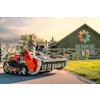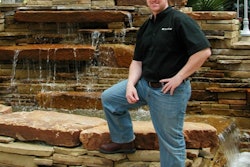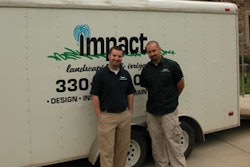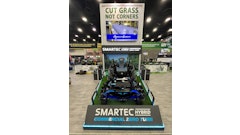Why in the world would a landscape designer decide that he’d rather be in the commercial maintenance business? Because, as this landscape designer so aptly puts it, “It’s simply a better business model for me.”
It wasn’t until a couple of years ago that Ben Collinsworth truly came to terms with his calling. “As a business owner, my primary job is to resolve conflicts and create opportunities,” he relates.
Collinsworth has been doing plenty of both since founding Native Land Design in 2001 at the age of 23. He and his trusted management team have learned to face challenges head-on, creating a company that is rapidly growing in more ways than one.
Sales – Since Native Land Design transitioned from residential construction to commercial maintenance in 2005, sales have more than doubled. The company has received plenty of attention for that sales growth. It has twice been named as one of Austin’s 50 fastest-growing companies. It was listed as one of Inc. Magazine’s 5,000 fastest-growing private companies in 2009. And it has won the prestigious Aggie 100 three times.
Footprint – Headquartered in Austin (Cedar Park), Native Land Design has opened three additional branches since 2005. The company is now a $10 million operation serving Austin, San Antonio, Houston and the Rio Grande Valley (McAllen).
People – “The professional atmosphere we’ve created tends to gravitate great talent to our company,” Collinsworth says. “We want to make sure we have an open environment for alternative thoughts and ideas. We practice open book management and constantly work to train our people to be more informed than their counterparts at other companies. Our employees truly have the ability to affect change at their positions.” Native Land Design employs 145 people year round, and an additional 55 during peak season.
Personal Transformation
Today, at age 33, Collinsworth is a much different person in the way he manages his growing company. Much of that personal transformation can be attributed to one simple thing: networking.
In 2008 Collinsworth began participating in something called TAB, which stands for The Alternative Board. TAB consists of several business owners from different industries in a certain geographic location. “Networking with other business owners from outside of the Green Industry has really helped us raise the bar,” Collinsworth says. “At first I was like, ‘I don’t really have any big issues to deal with.’ But once you get in a group like this and start talking, you realize that, ‘Man, I’ve got a ton of issues.’ And it does absolutely no good to run from them.”
Collinsworth’s personal transformation actually began well before his involvement in TAB. Back in 2003 he got in touch with consultant Jim Paluch of JP Horizons. “Jim really helped me sort through everything and figure out what my company’s focus should be,” Collinsworth says.
Company Transformation
That focus turned out to be commercial maintenance—namely homeowner associations (HOA’s), professional office complexes and retail centers.
In Native Land’s early days as a residential construction company, the majority of business was fed by big Austin-area homebuilders. Native Land Design also picked up some estate maintenance work in the process.
When one of Collinsworth’s clients turned him onto a large HOA maintenance account, a light bulb went on. “Commercial maintenance is a better business model with a lot less volatility than construction,” Collinsworth says.
It’s a good thing that the light bulb came on as quickly as it did. Native Land Design began its transition from construction to maintenance in 2005—several years ahead of the economic crash that crippled the construction business in 2009.
“We soon became a maintenance company that does install enhancements for maintenance clients, rather than an installation company that does maintenance for installation clients,” Collinsworth points out. “That has proved to be a very important difference for us.”
Put-up or Shut-up Time
As Native Land Design’s standing in the commercial maintenance arena strengthened, so did opportunities for expansion and growth. Initially operating solely in Austin, the company began landing some work south of the city. When a Native Land Design employee expressed a desire to move to San Antonio, Collinsworth decided to press some existing clients (developers and property managers) for work down there—and eventually opened a San Antonio branch in late 2005.
Stan Johnson, who Collinsworth knew from a stint with another landscape company 10 years ago, then joined Native Land Design that same year. “That’s when sales really took off,” Collinsworth says. Johnson’s reputation in the commercial maintenance arena really paid off when it came to building the company’s book of business.
The book grew quickly, and in 2007, when one of Johnson’s clients asked him to take a three-year, multi million-dollar maintenance contract down in Houston, Collinsworth found himself and his company at a crossroads. He recalls, “I looked at Stan and said, ‘Are we gonna’ do this?’” The harmonious answer was “yes”—the challenge was that they only had two weeks to do it.
“We needed 18 employees, four trucks and trailers, equipment, and a facility to operate from,” Collinsworth recalls. “Luckily, from his time working at another landscape company years ago, Stan had an inside track on some pretty good talent in the Houston area. We then bought our trucks, trailers and equipment from our vendors up in Austin, shipping it all down to our new Houston facility, which started out as a U-Haul storage unit until we got settled in and were able to find our own location.”
Native Land Design’s McAllen branch was launched in a similar fashion later that same year. Also in 2007, Miles Rush, another Texas landscape industry veteran, joined the company as vice president of operations, adding credibility much like Johnson had, in addition to bringing tremendous oversight for their markets. Michael Spell came aboard as controller two years later, assuming responsibility for accounting and financial reporting.
Can’t Force Growth
As suddenly as the company’s vast expansion unfolded, Collinsworth says that timeframe was less nerve-wracking than he would’ve expected. “When sales growth is driven by great opportunities, there’s a lot less to worry about—and the growth happens almost naturally,” he says.
That wasn’t the case back in Native Land Design’s early years. Operating in Austin, Collinsworth decided to open a branch in Dallas. Why? “I thought it would be cool because I grew up there and my parents still lived there,” Collinsworth says with a laugh. “I was 27 and didn’t know any better.”
Collinsworth also didn’t know any bankers, equipment dealers or other vendors in the Dallas market. He had few systems in place to help manage operations and track progress. “Our Dallas branch grew to $2.5 million in one year, but it was chaos behind the scenes,” Collinsworth says. “That fast growth was hard on cash flow, and really hard on me.” Collinsworth eventually sold the Dallas branch to his branch manager.
A New Approach to Business Development
Today, Native Land Design’s growth is organic. “Happy clients sell for us,” Collinsworth says. “We don’t care about fast growth anymore. In fact, we don’t even employ dedicated salespeople. We have one salesperson in San Antonio, but she spends most of her time on marketing activities such as events and networking.”
That doesn’t mean Collinsworth and his management team have become complacent, nor does it mean all business development efforts have stopped. Native Land Design just takes a different approach these days.
“Rather than spend a bunch of money on marketing, we choose to invest in the development of our company,” Collinsworth explains. “When it comes to our people, we have an aggressive training mentality and provide opportunities for advancement. Last year we had a big end-of-year party where we give away $15,000 worth of prizes.
“We also invest in marketing to existing customers,” Collinsworth continues. “We bought a big Texas Smoker bbq grill that we pull behind a truck. We throw parties for clients and do the cooking.”
Happy stomachs, happy clients. Native Land Design also strives to makes its clients smarter. “Through complete transparency in what we do, we develop relationships that allow us to be advisors on a property, as opposed to just vendors,” Collinsworth says. “It’s our job as the landscape operations experts to make sure clients are on the same page as we are.”
The company’s approach to bidding is much different than it was years ago. “The commercial maintenance business is not just about making money, it’s about meeting expectations,” Collinsworth says. “You can’t just take an RFP (request for proposal), measure a property and spit out a price. It’s about what the property actually needs, which is why we sometimes revise the RFP. If the customer declines, that’s fine—but 80% of the time the client appreciates what we did and hires us. Even if they don’t accept our suggested changes, clients simply appreciate that we’ve taken the time to offer our opinion.”
Now that Native Land Design is a mature company, Collinsworth says this approach is much more practical. It also helps that the company is no longer revenue-driven. When you’re chasing every job that’s out there, it’s hard to live up to everyone’s expectations and maintain an impeccable reputation. “We do not hard-sell,” Collinsworth says. “We present what the property needs, what we can do, and hope it’s a match with what the client wants.”









![Gravely Pro Turn Mach One My23 Dsc03139 Edit 1200x800 5b2df79[1]](https://img.greenindustrypros.com/mindful/acbm/workspaces/default/uploads/2025/10/gravely-pro-turn-mach-one-my23-dsc03139-edit-1200x800-5b2df791.BucBnDoN22.jpg?ar=16%3A9&auto=format%2Ccompress&fit=crop&h=135&q=70&w=240)











